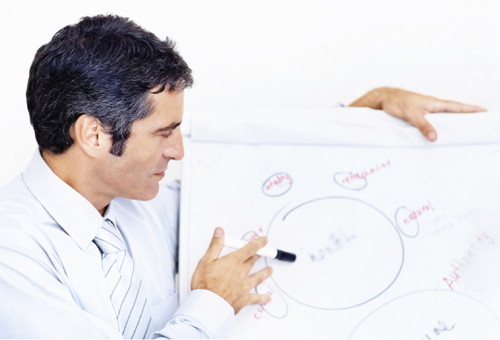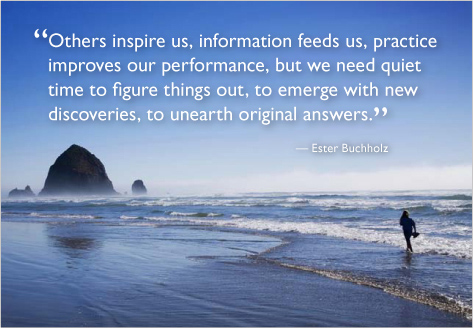Presentation Zen: Simple Ideas on Presentation Design and Delivery, 2nd Edition (Ira Katz's Library) (8 page)
Authors: Garr Reynolds

“If you have the ideas,
you can do a lot without machinery.
Once you have those ideas,
the machinery starts working for you....
Most ideas you can do pretty darn well
with a stick in the sand.”
—Alan Kay
(Interview in
Electronic Learning,
April 1994)
I spend a lot of time working outside my office in coffee shops, in parks, and while riding on the Japanese Bullet Train (
Shinkansen
) on my trips to Tokyo. And although I have a MacBook Air or iPad with me at virtually all times, it is pen and paper that I use to privately brainstorm, explore ideas, make lists, and generally sketch out my ideas. I could use the computer, but I find—as many do—that the act of holding a pen in my hand to sketch out ideas seems to have a greater, more natural connection to my right brain and allows for a more spontaneous flow and rhythm for visualizing and recording ideas. Comp- ared to sitting at a keyboard, the act of using paper and pen to explore ideas, and the visualization of those ideas, seems far more powerful. It’s certainly simple.

I often use a large whiteboard in my office to sketch out my ideas. The whiteboard works for me because I feel uninhibited and free to brainstorm and sketch ideas on a bigger scale. I can also step back (literally) and imagine how it might flow logically when slides are added later. The advantage of a whiteboard (or chalkboard) is that you can use it with small groups to record concepts and directions. As I write down key points and assemble an outline and structure, I can draw quick ideas for visuals, such as charts or photos that will later appear in the slides. I draw sample images that I can use to support a particular point, say, a pie chart here, a photo there, perhaps a line graph in this section, and so on.

You may be thinking that this is a waste of time: Why not just go into software and create your images there so you do not have to do it twice? Well, the fact is, if I tried to create a storyboard first on the computer, it would actually take longer, as I would constantly have to go from normal view to slide sorter view to see the whole picture. The analog approach (paper or whiteboard) to sketching out my ideas and creating a rough storyboard really helps solidify and simplify my message in my own head. I then have a far easier time laying out those ideas in PowerPoint, Keynote, Prezi, and so on. I usually do not even have to look at the whiteboard or legal pad when I am on the computer because the analog process itself gave me a clear visual image of how I want the content to flow. I glance at my notes for reminders about the visuals I thought of using at certain points and then go to iStockphoto.com or to my own library of high-quality stock images to find the perfect image.

Large sheets of paper and marking pens—as “old school” as they may seem—can be wonderful, simple tools for initially sketching out your ideas and recording the ideas of others. When I was at Apple, I sometimes led brainstorming sessions by sticking large Post-its on the wall. I wrote ideas down or others stepped up to the front and sketched out their ideas “the old-fashioned way” while arguing their point or elaborating on others’ ideas. It was messy, but it was a good mess. By the end of the session, the walls were filled with large Post-its, which I then took back to my office and stuck on my own walls. As we developed the structure and visuals for the presentation, we often referred to the sheets on the walls, which were on display for days or weeks. Having the content on the walls made it easier to see the big picture. It also made it easier to see what items could be cut and which were clearly essential to the core message.
Although you may be using digital technology to create your visuals and display them when you deliver your presentation, the act of speaking and connecting to an audience—to persuade, sell, or inform—is very much analog. For this reason, it only seems natural to go analog while preparing and clarifying your presentation’s content, purpose, and goals.


Slowing down is not just good advice for a healthier, happier, more fulfilling life, but it is also a practice that leads to greater clarity. Your instinct may be to say this is ridiculous—business is all about speed. First to innovate. First to market. First and fast.
What I am talking about here, however, is a state of mind. You have many things on your plate, no doubt. You are busy. But “busy” is not really the problem. Sure, there never seems to be enough time in the day to do things the way you would prefer to do them, and we all face time constraints. But time constraints can also be a great motivator, bringing a sense of urgency that stimulates creative thinking and the discovery of solutions to problems. The problem today, though, is not “busy” but “busyness.”
Busyness is that uncomfortable feeling you have of being rushed, distracted, and a bit unfocused and preoccupied. Although you may be accomplishing tasks, you wish you could do better. You know you can. But in spite of your best intentions, you find it difficult to create a state of mind that is contemplative rather than reactionary. You try. You take a deep breath. You begin to think about the big presentation next week. So you launch your application and begin to think. Then the office phone rings, but you let it go to voicemail because your boss is calling you on your mobile phone at the same time. “Need TPS reports ASAP!” she says. Then your e-mail notifies you that you’ve got new messages, including one from your biggest client with the subject line “Urgent! TPS reports missing!!!” Then your coworker pops his head in the door, “Hey, did you hear about the missing TPS reports?” So you get to work reacting even though you know that dealing with the reports could actually wait until another time. In this sort of environment, it is nearly impossible to slow down.
Busyness kills creativity. Busyness leads to the creation and display of a lot of cluttered presentation visuals that substitute for engaging, informative, and provocative meetings, seminars, or keynote speeches where actual conversations could and should be taking place. But people feel rushed, even frantic. So they slap together some slides from past presentations and head off to their presentation. Communication suffers...the audience suffers. Yes, we’re all insanely busy, but this is just all the more reason we owe it to ourselves
and our audiences not to waste time with perfunctory “slideshows from hell.” To do something better takes a different mindset, and it takes time and space away from “busyness.”
When you think about it, the really great creatives—designers, musicians, even entrepreneurs, programmers, etc.—are the ones who see things differently and who have unique insights, perspectives, and questions. (Answers are important, but first come questions.) For many of us, this special insight and knowledge, as well as plain ol’ gut feeling and intuition, can only come about when slowing down, stopping, and seeing all sides of our particular issue. It does not matter if you are a scientist, engineer, medical doctor, or businessperson. When you prepare a presentation, you are a “creative,” and you need time away from the computer and dealing with digital outlines and slides. And whenever possible, you also need time alone.
One reason many presentations are so ineffective is that people today just do not take—or do not have—enough time to step back and really assess what is important and what is not. They often fail to bring anything unique, creative, or new to the presentation. This is not because they are not smart or creative beings, but because they did not have the time alone to slow down and contemplate the problem. Seeing the big picture and finding your core message may take some time alone “off the grid.” There are many ways to find solitude, and you don’t even have to be alone. I find a very pleasant form of solitude, for example, at a Starbucks in central Osaka, where the friendly staff know me by name. It’s a bustling café but also cozy and relaxing with loads of overstuffed sofas and chairs and jazz playing softly in the background. And I am left alone.
I’m not suggesting that more time alone is a panacea for a lack of ideas or that it necessarily leads to more creativity or better solutions. But I think you will be pleasantly surprised if you can create more time every day, week, month, and year to experience solitude. For me, solitude helps achieve greater focus and clarity while also allowing me to see the big picture. Clarity and the big picture are the fundamental elements missing from most presentations.
I don’t want to overly romanticize solitude. Too much “alone time” obviously can be a bad thing as well, yet in today’s busy world, too much solitude is a problem faced by few of us. For most professionals, finding some time alone can be a great struggle indeed.
The Need for Solitude
Many believe solitude is a basic human need, and to deny it is unhealthy for both mind and body. Dr. Ester Buchholz, a psychoanalyst and clinical psychologist who passed away in 2004 at the age of 71, did quite a bit of research on solitude during her career—she called it “alone time.” Dr. Buchholz thought society undervalued solitude and alone time and overvalued attachment. Dr. Buchholz thought periods of solitude were important if we were to tap our creative potential. “Life’s creative solutions require alone time,” she said. “Solitude is required for the unconscious to process and unravel problems.” The second half of Dr. Buchholz’s quote appears in the slide below, a slide I have used in some of my talks on creativity.

Image in slide from iStockphoto.com.